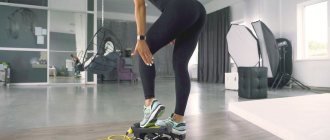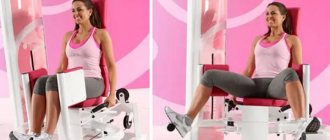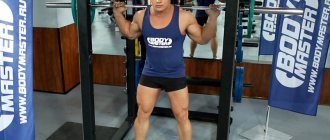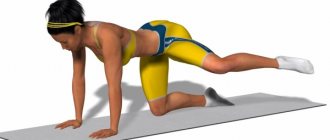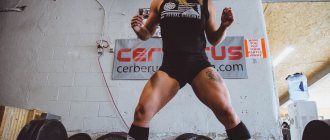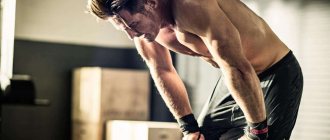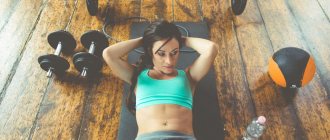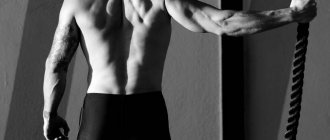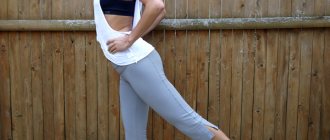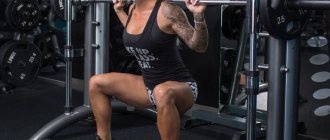What does it develop and what is the name of the simulator?
So, the abduction and extension of the legs in a sitting machine help us in training the legs, but these two movements are aimed at different muscles: if the extension of the legs is aimed at training the muscles of the outer surface of the thigh, then the abduction is aimed at training its inner surface . The exercise is an isolation exercise. Suitable for both women and men.
By the way, it often happens that the simulator is capable of performing only one movement: either adduction or extension. It depends on the design of the simulator. To tell the truth, this is terribly inconvenient in our opinion, but the gym needs to be filled with something. Many fitness centers have these machines. Their design includes a soft seat, a lever system, a compartment for weight adjustment and two stops equipped with soft bolsters, against which the knees rest.
It is difficult to make a mistake in performing these exercises, since they are simple and understandable.
Standing leg raises in the simulator
In fact, a special machine for standing leg raises exists, but it is very rare. Its difference from a sitting exercise machine is the absence of a seat and the presence of front handles for fixing the body.
Standing leg raiser
But this exercise can also be performed on a sitting machine; to do this, just put your feet on the stands, lean forward, holding on to the structure of the machine, raise your pelvis and hold the canopy throughout the approach. There is no need to move your legs too far; the range of movement remains the same. This option allows you to put more stress on the buttocks, including the gluteus minimus muscle. In this case, the flexors and extensors of the legs are loaded in a static position.
What muscles work
When spreading the legs while sitting, which muscles are involved:
- abductors - adductors, gluteus medius and minimus.
- Stabilizing muscles: quadratus dorsi, erector spinae and abdominal muscles.
Dear girls, we remind you that by developing these muscles, you will not reduce the amount of fat in this problem area. The main task of the leg abduction and abduction exercise in the simulator is to strengthen muscles, and not to get rid of fat deposits.
An article explaining why everything is so unfair: Why don’t we lose weight locally or how to burn fat?
Muscle atlas when bringing the legs together :
- adductors are the muscles of the inner thighs. An important point: they are very little involved in everyday life.
Lying leg extensions in the simulator
This kind of exercise machine is also rare, but some designs provide for changing the inclination of the back of the machine. This technique reduces the load on the spine and lumbar muscles, which allows you to train during the recovery period after injuries and with spinal problems. There is no need to move your legs too wide. In this position, the lower part of the gluteus maximus muscle works more strongly.
Technique with photos: how to do it correctly?
As we wrote above, the exercises are not complicated and do not require any special skills. So, how to do it correctly with and without a simulator:
Sitting
Performing leg reduction in the simulator:
- Set the required weight for the weights on the machine and adjust the position of the backrest. Take a starting position in which your legs are spread apart and rest against the bolsters or cushions of the machine, straighten your back and rest it against the back of the seat.
- Legs should be bent at an angle of 90 degrees or more. Take a deep breath.
- As you exhale, tighten your hips and begin to bring your legs together. Do not change the angle of leg bending.
- At the finishing point (legs are completely brought together), stay in this position for 1-2 seconds and tighten the hip adductors as much as possible.
- Starting to inhale, spread your legs slowly, without jerking, while observing the technique. Do not bring your legs to the starting position in order to leave the muscles in a tense state. Repeat the movements several times in accordance with the training program.
Dear, I accelerated my metabolism or myths about “hyped” metabolism
How to use the breeding machine:
- Take your starting position. Sit on the machine so that your thighs are between the side supports. Grasp the handles with your hands, straighten your chest and straighten your back. Now you can start spreading your legs in the simulator.
- As you inhale, tighten your abs and spread your legs as far apart as possible. Hold in the extreme position for a few seconds.
- Slowly return to the starting position and exhale. Your legs should move towards each other not under the pressure of the exercise pads, but as if resisting it. This means that we do not completely relax the muscles and perform the movement completely under control.
Since these exercises relate to isolation, you should not chase the scales. Very often, girls, inspired by the ease of execution, begin to boast a little about their “strength” and quickly increase the weight. Isolation is just your assistant, your main tool is the queen base (basic exercises). If you don’t do the base or add fillet when doing it, then you can say goodbye to a beautiful body, 100% guarantee.
We are not saying that isolation is bad, no! Isolation exercises greatly help us to qualitatively load a muscle that is previously fatigued by the base. And then there are those unique people who lift and raise 40 kg, but squat every other time and barely.
Conclusion: insulation is good, but without a base it’s still impossible.
We strongly recommend that you familiarize yourself with the technique of performing basic exercises: Do the basics, beauty! .
Bent over
If the machine allows you to change the angle of the backrest, take advantage of this chance. By performing leg raises while sitting in a backward bend, you will maximally load the target muscles - the gluteus medius and minimus.
Reduction and extension with forward bend:
If you keep your body straight or lean forward, the upper part of the gluteus maximus muscles will engage. By the way, another great exercise for the so-called “upper buttocks” is gluteal swings .
Standing
To do this, we turn our backs to the standing exercise machine and the bolsters, grab the back of the chair with our hands and rest our knees against it. The back should be straight and the pelvis should be slightly back. As you exhale, we bring our legs together, resting our feet on the bolsters, and as we inhale, we spread them apart. The legs should not move by inertia - tension should always be present.
Or this option.
From the lower block in the crossover
As for the gym, a replacement for leg extensions can be a side swing from the lower block, which works the thigh muscles. For greater effect, you can first work out with blocks, and then proceed to the “adjustable” simulator.
With elastic band
An interesting option for exercising at home is a real home gym! There are a lot of variations, it all depends on your convenience and imagination. Here are some ideas:
- Extension and abduction of legs while lying on your side . Place the resistance band on your shin for added resistance on your outer thigh. We raise our leg, hold it at the peak point of tension, and lower it. Don't lean forward or backward or turn your hips in or out. During movement, the core muscles also work. Keep the feet of both feet parallel. By turning your feet toes, you will work your hip external rotators.
- Sideways on your knees
- Lateral exercise while lying on your back on the floor . Take a lying position, straighten your arms along your spine, lift your legs up. Spread them apart and bring them together with an elastic band stretched over your shins. Move the resistance band higher if the exercise seems too difficult. You can also make it a plus by lifting your pelvis upwards and then bringing your legs together!
- Sitting on a chair for women . Sit on a chair/sofa/bench. Place the elastic band above the knees, on the hips: this way the load will fall much better than when the expander is located just below the knee. Place your feet so that the band is taut and the load is felt. Lean your body forward. Extend and contract your knees, holding at the highest point of tension for 3 seconds. In it, make pulsating movements, but not back and forth, but only forward, spreading your legs wider!
Breeding legs in a simulator for varicose veins - read the True answer, is it possible to play sports with varicose veins
Street trainer
Leg extensions in the forward bending machine
This option will be performed in the same way as the previous one. One difference is the forward tilt of the torso by almost 45 degrees. At the same time, it is important to keep your back straight. This technique puts more stress on the upper gluteus maximus muscle.
Tips for Maximum Benefit
- Before performing the exercise, stretch your hip joints and stretch your inguinal ligaments. This will allow the muscles to better absorb the load and also increase the range of motion. You can see effective joint gymnastics in this article .
- Make sure your back remains straight . Under no circumstances should you hunch your back on the last reps! If you don't have the strength left, shorten the exercise or help yourself overcome the resistance with your arms.
- Work slowly and avoid sudden movements. Try not to use the force of inertia.
- Cool down plays an important role . Your muscles will only be flexible enough if you don't skip post-workout stretching, which helps flush out lactic acid from your muscles, thereby relieving the soreness that usually occurs the day after a workout.
Basic mistakes and useful tips
For the training to be most effective, the following recommendations must be followed:
- While performing the element, keep an eye on the body - it should always be straight. Also avoid any displacement of the back relative to its original position.
- Your legs should be spread as far apart as possible.
- You need to spread your legs powerfully, and bring them together slowly and under control - there should be pressure, not a contraction by inertia.
- There is no need to bring the limbs down to the end; there should be a small gap that maintains muscle tension.
- At the end point you need to pause and perform a peak contraction.
- Hands should always be placed on the side handles.
- Follow the breathing technique: exhale with effort - dilation, inhale - with reduction.
- Make sure that during the training process only the hip joints work. The ankle and knees should not be involved.
- Try to keep your toes pointed outward at all times, so your buttocks will receive the most stress.
- Watch the outer surface of the thigh - it should touch the machine tightly. Otherwise, the load will transfer to the quadriceps.
- Choose the right weight. It shouldn’t be too heavy, but you also shouldn’t leave the exercise machine without being tired. The optimal weight will be at which the last repetitions are difficult and with a burning sensation in the muscles.
Read also: Exercises for arm strength
Need to know! The simulator allows you to not only work out the outer surface of the thigh. Knowing some nuances, you can also effectively use the buttocks. To do this, you need to change the tilt of the seat back. The gluteus medius will work more in a backward position, and the gluteus maximus will work more in a vertical position.
What to replace it with?
The leg abduction and abduction exercise machine cannot be called very effective. It can be replaced with the exercise “Steps with a rubber band to the sides” and a plie squat .
- Technique for performing exercises with a tape: Attach the tape to your ankles and, stretching the projectile, take small steps left and right. Then stand with your feet straight, shoulder-width apart, toes pointing to the sides. Keeping your back straight and your buttocks lowered, lower yourself into a squat so that your thighs are parallel to the floor. Return to the starting position. For clarity, watch the video.
By the way, these exercises will help you solve the problem of “walking” knees when squatting. It is very common for those who begin to squat with a barbell to experience knee cramps as soon as they add weight to their back. This is a common problem, but it can be solved with these exercises. You will strengthen the small muscles and ligaments that hold the kneecap and teach yourself to keep your knees straight.
It is better to leave the exercise for finishing, after the squat.
- Plie squat quite easy to do. Stand up straight, statically tense your abs and pick up the dumbbell at the base/kettlebell by the handle. Stand with your feet wider than shoulder-width apart, knees slightly bent, and feet pointed outward (to about a 45-degree angle). Turning your feet 45 degrees is purely conventional, your legs should be placed as far as the flexibility of your body allows without compromising your technique, so that you feel comfortable. Place the dumbbell between your legs. This is the starting position.
As you inhale, begin to lower yourself down, slowly bending your knees. The knees should not go beyond the feet and should not be brought together, but should seem to go to the sides (work like scissors). Lower yourself until your thighs are parallel to the floor. As soon as you feel a good stretch in the adductor muscles, exhale and return your body to the starting position, pushing your heel off the floor.
Those. inhale - we go down, exhale - we go up. Repeat the specified number of times. At the top of the movement, do not lock or lock your knees. Correct execution should cause a feeling of tension in the quadriceps, inner thighs and buttocks.
Throughout the entire movement, keep your back straight and the apparatus close to your body. Your arms should not “walk”, but they should not pull weight either; try to transfer the entire load to the buttocks. How to do it? You will find the answer in the article “ Concentration in training: shaking your butt with your head .” Be sure to pay attention to the pace: do the exercise smoothly and without jerking.
If you have difficulty maintaining balance, do plie squats with your back against the wall. It is better to put the exercise at the beginning of the workout, and do a 5-10 minute warm-up before it. Do not lower your head or look at your feet; it is better to turn sideways to the mirror and record the quality of your technique. For greater depth of squat and accentuated development of the buttocks, you can use step platforms under each of the legs.
How to effectively pump up Madame Sizhu: plie and sumo squats
What to combine with?
Exercises on this machine can be used as auxiliary to the main ones (or rehabilitation in case of injury) and included at the end of the workout , but working only with it will not give any progress in improving the shape of the legs, remember this and do not fall for the machine as an exclusive one for training muscles inner thigh.
I think a reasonable question has arisen: why are such not very effective exercise machines installed in gyms? The answer is that if they did not exist, fitness centers would discourage most of their female clientele from visiting them. Coupled with the fact that women are afraid of free weights and becoming too big and muscular, it is easier for them to choose a light load for themselves.
So ladies, when it comes to improving the shape of your inner thighs, use the adductor machine wisely and don't focus on it alone.
Harm
Let us immediately ask you to note that we are not declaring that this simulator is harmful. Exercises on this machine are useful in moderation with small weights and a small total monthly volume of their use. They really create muscle tone in the abductor and adductor muscles of the thigh, improve the tone of the gluteus medius and minimus muscles, and improve blood circulation in these places.
However, they do not remove excess fat at all and, moreover, these exercises can even be harmful.
(Degree of tediousness: acceptable)
We have already mentioned that the range of motion in this simulator is unnatural for the body, i.e. This movement is not used anywhere outside the gym. And the adductor muscles themselves (which this exercise is aimed at) do not work very much in life. These muscles are a complex of muscles located deep on the inner surface of the thigh and groin. They are difficult to find, because... they are “buried” under other muscles, such as the quadriceps. You use these muscles when climbing stairs, climbing hills, and standing up. Progress in weight comes quite quickly, but the higher it is, the more it strains the spine. The kneecap will also not thank you for the ever-increasing load.
How to reduce the stress on your knees when playing sports?
Thus, it turns out that no matter how you use the leg adduction machine, it most likely will not change your leg composite composition, for these purposes it is a useless tool. And it's all about the biomechanics of movement. The design of the exercise machine itself is sedentary, so the thigh muscles do not work in any way in this position. It often happens that people come to the gym after a hard, sedentary day in order to get their blood flowing and tone their muscles.
And, oddly enough, they choose on their own (or on the advice of a trainer) a sedentary machine to train their muscles. This is not true. Exercises that require balance and use free weights and weighted walking/standing should be selected. In particular, leg tucks can be replaced with cross lunges or leg abductions on a block - they allow you to achieve significantly better “tuning” of the legs.
What has been written should not be taken as a complete failure of the adductor simulator to work the corresponding muscles.
The main harm is that when you spread your legs in the exercise machine in a large volume, and especially with good weights, the piriformis muscles gradually develop and spasm .
The origin of the piriformis muscle is on the anterior surface of the sacrum, and it is attached to the femur. The function of the piriformis muscle is abduction and supination of the hip. Below the piriformis muscle is the sciatic nerve , the longest nerve in the body, running from the lower spine, through the buttocks and thighs, and down the back of the leg. Although this nerve is found in both legs, symptoms of a pinched sciatic nerve usually appear in only one leg.
Have you ever felt, when performing this exercise, that your thigh was “cramping” , some kind of aching pain when moving to the sides, deep inside? No, this is not a muscle that you pumped up so well, it’s a poor nerve asking for mercy.
Pinching symptoms:
- The very first symptom of a pinched sciatic nerve is pain, which usually begins in the lower back and spreads along the entire length of the nerve: through the buttocks, to the thighs and calves. The intensity of pain can vary from mild to very acute. Sometimes the pain manifests itself in the form of a burning sensation, in other cases it can be similar to electric shocks.
- Another common symptom of a pinched sciatic nerve is numbness that affects part or all of the leg. Numbness in one area may be accompanied by pain in another. In addition, usually a person also experiences a characteristic tingling sensation in the toes.
- One of the most distressing symptoms of a pinched sciatic nerve is loss of bladder or bowel control. This condition is rare and requires emergency medical attention. Sometimes this symptom of a pinched sciatic nerve is accompanied by lumbosacral radiculitis.
When the legs are brought together in the simulator, with a spasmodic piriformis muscle, even greater compression of the sciatic nerve occurs and symptoms worsen or appear.
Conclusion : this machine can be used in your training program, but with light weights and a maximum of 1 time per week.
Inclusion in the training plan
Despite the fact that the person in the machine sits with his knees bent, the exercise is considered a single-joint exercise. In the absence of injury, it is usually included in the general program after multi-joint leg development (for example, squats or platform presses). Care should be taken to select the load, not placing a weight that the athlete is not able to lift more than 10 times.
It is permissible to perform this exercise separately several times a week. You can do it every day in combination with squats if the goal is to correct your squat technique.
It is contraindicated to do leg extensions/reductions under load in case of injury to the hip joints, as well as inflammatory processes. This restriction applies until the moment of rehabilitation - when power loads are allowed. This exercise is performed under the guidance of a trainer for osteochondrosis and hernias in the lumbar spine. Any back twisting is avoided.
